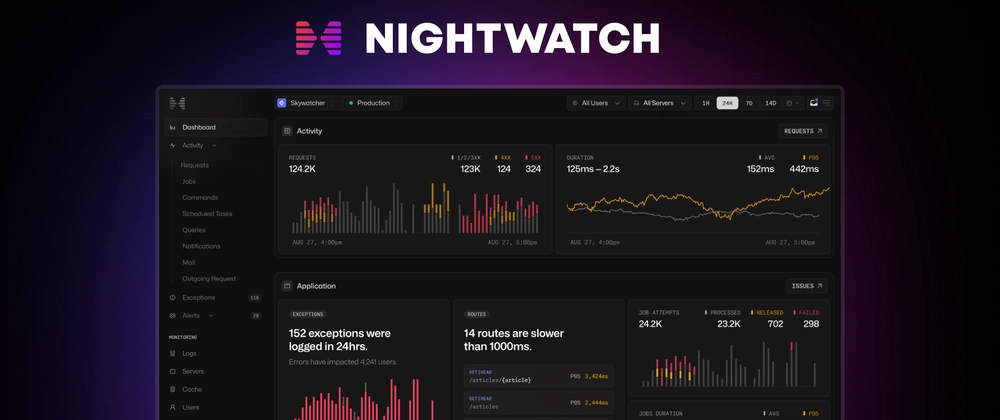Mastering Laravel Nightwatch for Efficient Web Development
In the ever-evolving world of web development, Laravel and Nightwatch stand out as powerful tools for building and testing web applications. This article delves into how combining Laravel’s robust backend capabilities with Nightwatch’s efficient end-to-end testing can streamline your development process, ensuring high-quality, reliable web applications.
Understanding Laravel and Nightwatch
Laravel and Nightwatch are two powerful tools that, when combined, create a robust ecosystem for web development and testing. Laravel, a PHP framework, excels in building scalable and maintainable web applications. Its elegant syntax, built-in features like Eloquent ORM, and seamless integration with front-end tools make it a developer favorite. On the other hand, Nightwatch, a Node.js-based end-to-end testing framework, specializes in automating browser testing. Its simplicity, compatibility with Selenium, and support for behavior-driven development (BDD) make it ideal for ensuring application reliability.
The synergy between Laravel and Nightwatch lies in their complementary strengths. Laravel provides a solid backend foundation, while Nightwatch ensures the frontend behaves as expected. For instance, Laravel’s Artisan commands can be used to seed databases with test data, which Nightwatch can then validate across different browsers. Additionally, Laravel’s Dusk integration can be extended with Nightwatch for more complex testing scenarios, such as handling JavaScript-heavy applications.
By leveraging Laravel’s backend capabilities and Nightwatch’s frontend testing prowess, developers can achieve a seamless workflow. This combination not only accelerates development but also ensures high-quality, bug-free applications, making it a cornerstone of modern web development practices.
Setting Up Your Development Environment
To set up a development environment that integrates Laravel and Nightwatch, start by ensuring your system meets the prerequisites. You’ll need PHP (preferably version 8.0 or higher), Composer, Node.js, and npm installed. Begin by creating a new Laravel project using Composer: run composer create-project –prefer-dist laravel/laravel project-name. Navigate to your project directory using cd project-name. Next, install Nightwatch.js by running npm install nightwatch –save-dev. Nightwatch requires a browser driver like ChromeDriver or GeckoDriver for Firefox. Install ChromeDriver globally or locally using npm install chromedriver –save-dev. Configure Nightwatch by creating a nightwatch.conf.js file in your project root. Define the browser settings, test directory, and other configurations in this file. For Laravel-specific testing, install the Laravel Dusk package via Composer: composer require –dev laravel/dusk. Run php artisan dusk:install to set up Dusk, which integrates seamlessly with Nightwatch. Finally, update your package.json to include Nightwatch scripts for running tests. With these steps, your environment is ready for efficient Laravel and Nightwatch integration.
Creating Your First Laravel Project
To create your first Laravel project, start by ensuring your development environment is fully set up, as detailed in the previous chapter. Open your terminal and navigate to the directory where you want to create the project. Run the command composer create-project laravel/laravel project-name, replacing project-name with your desired project name. This command installs Laravel and all its dependencies. Once the installation is complete, navigate into the project directory using cd project-name.
Next, configure your .env file to match your local environment settings. Update the database credentials to ensure Laravel can connect to your database. Run php artisan key:generate to set the application key, which is crucial for security and encryption.
To prepare for Nightwatch testing, install Node.js dependencies by running npm install. This installs the necessary packages listed in package.json. Ensure your project structure adheres to Laravel’s conventions, keeping the tests directory organized for future Nightwatch integration. Finally, verify your setup by running php artisan serve and accessing the application in your browser. This solid foundation ensures a seamless transition to integrating Nightwatch in the next chapter.
Integrating Nightwatch into Laravel
To integrate Nightwatch into a Laravel project, start by installing Nightwatch via npm. Run npm install nightwatch –save-dev in your project directory. This installs Nightwatch and its dependencies. Next, create a nightwatch.conf.js file in the root directory. This configuration file defines settings like test environments, browser drivers, and test directories. Use the following structure as a starting point:
module.exports = {
src_folders: ['tests/e2e'],
webdriver: {
start_process: true,
server_path: require('chromedriver').path,
port: 9515,
},
test_settings: {
default: {
desiredCapabilities: {
browserName: 'chrome',
},
},
},
};
This configuration sets up Chrome as the default browser for testing. Ensure chromedriver is installed via npm install chromedriver –save-dev. Next, create a tests/e2e directory to store your end-to-end tests. Add a basic test file, such as exampleTest.js, to verify the setup. The file should include a simple test case:
module.exports = {
'Example test': function (browser) {
browser
.url('http://localhost:8000')
.waitForElementVisible('body', 1000)
.assert.title('Your Laravel App')
.end();
},
};
Finally, update your package.json to include a script for running Nightwatch: “e2e”: “nightwatch”. Run npm run e2e to execute your tests. This seamless integration ensures your Laravel project is ready for robust end-to-end testing.
Writing Your First Nightwatch Test
Writing your first Nightwatch test in a Laravel project is a straightforward yet powerful step toward ensuring your application behaves as expected. Begin by creating a new test file in the tests/Browser directory. For example, ExampleTest.js. This file will serve as the foundation for your end-to-end testing.
A basic Nightwatch test structure includes a module.exports object containing one or more test scenarios. Each scenario is defined within a function that accepts a browser parameter, representing the browser instance. For instance, to test a login page, you might write:
module.exports = {
'Test Login Page': function (browser) {
browser
.url('http://localhost:8000/login')
.waitForElementVisible('body', 1000)
.assert.title('Login Page')
.setValue('input[name="email"]', 'user@example.com')
.setValue('input[name="password"]', 'password')
.click('button[type="submit"]')
.assert.urlContains('dashboard')
.end();
}
};
This script navigates to the login page, verifies the title, fills in the credentials, submits the form, and checks if the user is redirected to the dashboard. Nightwatch’s chaining syntax makes it easy to write readable and maintainable tests.
Common testing scenarios include form submissions, navigation checks, and UI element validations. Use .assert methods to verify expected outcomes and .waitForElementVisible to handle dynamic content. By mastering these basics, you’ll be ready to explore advanced strategies in the next chapter.
Advanced Testing Strategies with Nightwatch
Advanced testing strategies with Nightwatch in Laravel involve handling complex scenarios that go beyond basic user interactions. One key technique is managing asynchronous operations, such as AJAX requests or dynamic content loading. Nightwatch’s built-in waitForElementVisible and waitForElementNotPresent commands ensure tests wait for elements to appear or disappear, preventing false negatives. For more granular control, custom wait conditions can be implemented using JavaScript callbacks.
Another advanced strategy is simulating complex user interactions, like drag-and-drop, multi-step forms, or keyboard shortcuts. Nightwatch’s .moveToElement and .perform methods enable precise mouse movements and actions, while .keys handles keyboard inputs. These interactions are crucial for testing modern, interactive web applications.
Data-driven testing is another powerful approach, allowing you to run the same test with multiple datasets. By leveraging Nightwatch’s support for external data sources like JSON or CSV files, you can create reusable tests that validate various input combinations. This is particularly useful for testing forms, search functionalities, or API responses.
Finally, integrating Nightwatch with Laravel’s testing ecosystem, such as Dusk or PHPUnit, enables seamless end-to-end testing. Combining these tools ensures comprehensive coverage, from unit tests to browser-based scenarios, while maintaining consistency across your testing suite.
Optimizing Test Performance
Optimizing the performance of Nightwatch tests within Laravel projects is crucial for maintaining a fast and reliable development workflow. One effective strategy is to parallelize test execution. By splitting tests into smaller, independent groups and running them concurrently, you can significantly reduce execution time. Tools like Laravel Dusk or Nightwatch’s built-in parallel execution can help achieve this. Additionally, minimizing browser interactions by using headless browsers or disabling unnecessary UI elements can speed up tests without compromising reliability.
Another key aspect is optimizing test data management. Instead of recreating test data for every test, use Laravel’s database seeding and factories to preload data once and reuse it across multiple tests. This reduces database overhead and improves consistency. Furthermore, leveraging caching mechanisms for static assets or API responses can prevent redundant network requests, further enhancing performance.
To ensure reliability, implement retry mechanisms for flaky tests caused by timing issues or network latency. Nightwatch’s retry functionality can automatically rerun failed tests, reducing false negatives. Lastly, regularly review and refactor tests to eliminate redundant steps or outdated assertions, ensuring they remain efficient and aligned with the application’s current state. These optimizations collectively streamline your testing process, making it faster and more dependable.
Debugging and Troubleshooting Tests
Debugging and troubleshooting Nightwatch tests in Laravel can be challenging, but with the right tools and practices, you can efficiently identify and resolve issues. Start by leveraging Laravel’s built-in logging and Nightwatch’s debug mode. Enable debug mode by adding –verbose or –devtools flags to your Nightwatch commands. This provides detailed logs and opens Chrome DevTools, allowing you to inspect elements and network requests in real-time.
For more granular control, use console.log() within your test scripts to output specific values or states during execution. Additionally, Laravel’s Dusk can complement Nightwatch by providing browser-based debugging capabilities, such as screenshots and page source dumps.
Common issues include element selectors failing due to dynamic content or timing issues. Use waitForElementVisible or pause to handle asynchronous behavior. If tests fail intermittently, consider increasing timeouts or refactoring flaky assertions.
For deeper analysis, integrate Xdebug with Laravel to step through server-side code during test execution. Pair this with Nightwatch’s afterEach hook to capture screenshots or logs on failure.
Finally, maintain a clean test environment by isolating dependencies and using Laravel’s DatabaseTransactions trait to reset the database state after each test. These practices ensure your tests are reliable and easier to debug, paving the way for seamless integration into CI/CD pipelines.
Continuous Integration and Deployment
Incorporating Nightwatch tests into a continuous integration and deployment (CI/CD) pipeline for Laravel projects ensures that your application is rigorously tested with every build, reducing the risk of introducing bugs into production. To achieve this, you can integrate Nightwatch with popular CI/CD tools like GitHub Actions, GitLab CI/CD, or Jenkins. Start by configuring your pipeline to install dependencies, including Laravel and Nightwatch, using composer and npm. Next, set up a script to run your Nightwatch tests automatically after each build. For example, in GitHub Actions, you can define a workflow file that triggers on push or pull requests, installs dependencies, and executes Nightwatch tests using the npm run test command.
Ensure your pipeline includes environment variables for database configurations and other sensitive data, using secure storage mechanisms like GitHub Secrets. Additionally, configure your pipeline to generate and store test reports, which can be reviewed for debugging or compliance purposes. Tools like Allure or JUnit can be used to format and visualize these reports. By automating Nightwatch tests in your CI/CD pipeline, you not only streamline development but also maintain high-quality standards, ensuring that every deployment is robust and reliable. This approach aligns with the debugging strategies discussed earlier and sets the stage for adopting best practices and future trends in testing.
Best Practices and Future Trends
When using Laravel and Nightwatch together, adhering to best practices ensures efficient testing and development workflows. Modularize your tests by breaking them into smaller, reusable components, making them easier to maintain and debug. Use Laravel’s built-in testing utilities, such as factories and seeders, to create consistent test data, ensuring your Nightwatch tests run against predictable environments. Leverage environment variables to manage configurations like database connections or API keys, keeping your tests adaptable across different stages of development. Additionally, integrate Nightwatch with Laravel Dusk for end-to-end testing, combining the strengths of both tools for comprehensive coverage.
As for future trends, AI-driven testing is gaining traction, enabling smarter test generation and anomaly detection. Tools like Nightwatch may soon incorporate machine learning to optimize test cases and reduce flakiness. Another emerging trend is the shift toward headless browser testing, which improves speed and resource efficiency. With the rise of progressive web apps (PWAs) and single-page applications (SPAs), testing frameworks are evolving to handle dynamic content and asynchronous behavior more effectively. Staying updated with these trends ensures your Laravel and Nightwatch workflows remain cutting-edge, delivering robust and scalable web applications.

Conclusions
Combining Laravel and Nightwatch offers a powerful solution for developing and testing web applications. By following the strategies and practices outlined in this article, developers can enhance their workflow, improve application quality, and stay ahead in the fast-paced world of web development. Embrace these tools to build more reliable, efficient, and scalable web applications.



